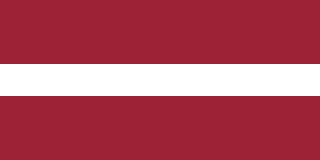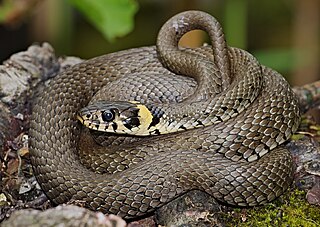
The Balts or Baltic peoples are a group of peoples inhabiting the eastern coast of the Baltic Sea who speak Baltic languages. Among the Baltic peoples are modern-day Lithuanians and Latvians — all East Balts — as well as the Old Prussians, Curonians, Sudovians, Skalvians, Yotvingians and Galindians — the West Balts — whose languages and cultures are now extinct.

Latvia, officially the Republic of Latvia, is a country in the Baltic region of Northern Europe. It is one of the three Baltic states, along with Estonia to the north and Lithuania to the south. It borders Russia to the east, Belarus to the southeast, and shares a maritime border with Sweden to the west. Latvia covers an area of 64,589 km2 (24,938 sq mi), with a population of 1.9 million. The country has a temperate seasonal climate. Its capital and largest city is Riga. Latvians belong to the ethnolinguistic group of the Balts and speak Latvian, one of the only two surviving Baltic languages, a branch of the Indo-European language family. Russians are the most prominent minority in the country, at almost a quarter of the population.

Riga is the capital, primate, and the largest city of Latvia, as well as the most populous city in the Baltic States. Home to 605,273 inhabitants, the city accounts for a third of Latvia's total population. The population of Riga metropolitan area, which stretches beyond the city limits, is estimated at 860,142. The city lies on the Gulf of Riga at the mouth of the Daugava river where it meets the Baltic Sea. Riga's territory covers 307.17 km2 (118.60 sq mi) and lies 1–10 m (3–33 ft) above sea level on a flat and sandy plain.
Latvian mythology is the collection of myths that have emerged throughout the history of Latvia, sometimes being elaborated upon by successive generations, and at other times being rejected and replaced by other explanatory narratives. These myths, for the most part, likely stem from Proto-Indo-European practices and the later folk traditions of the Latvian people and pre-Christian Baltic mythology.

The Baltic states or the Baltic countries is a geopolitical term encompassing Estonia, Latvia, and Lithuania. All three countries are members of NATO, the European Union, the Eurozone, and the OECD. The three sovereign states on the eastern coast of the Baltic Sea are sometimes referred to as the "Baltic nations", less often and in historical circumstances also as the "Baltic republics", the "Baltic lands", or simply the Baltics.

Limbaži District was an administrative division of Latvia, located in Vidzeme region, in the country's north-east, on the shore of the Baltic Sea. It bordered Estonia in the north, the former districts of Riga in the south and Valmiera in the east, and the Gulf of Riga in the west. It covered the territory of the medieval Livonian county of Metsepole. The main city in the district was Limbaži.

The world tree is a motif present in several religions and mythologies, particularly Indo-European, Siberian, and Native American religions. The world tree is represented as a colossal tree which supports the heavens, thereby connecting the heavens, the terrestrial world, and, through its roots, the underworld. It may also be strongly connected to the motif of the tree of life, but it is the source of wisdom of the ages.

The grass snake, sometimes called the ringed snake or water snake, is a Eurasian semi-aquatic non-venomous colubrid snake. It is often found near water and feeds almost exclusively on amphibians.

The Venta is a river in north-western Lithuania and western Latvia. Its source is near Kuršėnai in the Lithuanian Šiauliai County. It flows into the Baltic Sea at Ventspils in Latvia.

Semigallia, also spelt Semigalia, is one of the Historical Latvian Lands located to the south of the Daugava river and to the north of the Saule region of Samogitia. The territory is split between Latvia and Lithuania, previously inhabited by the Semigallian Baltic tribe. They are noted for their long resistance (1219–1290) against the German crusaders and Teutonic Knights during the Northern Crusades. Semigallians had close linguistic and cultural ties with Samogitians.
Baltic mythology is the body of mythology of the Baltic peoples stemming from Baltic paganism and continuing after Christianization and into Baltic folklore.
Rhemaxos was an ancient king who ruled to the north of Danube around 200 BC and who was the protector of the Greek colonies in Dobruja, receiving a tribute from them in exchange of protection against outside attacks. It appears that the links with the Greek cities lasted a rather long time, as several treaties have been found.

Eglė the Queen of Serpents, alternatively Eglė the Queen of Grass Snakes, is a Lithuanian folk tale, first published by M. Jasewicz in 1837.
Baltic Romani is group of dialects of the Romani language spoken in the Baltic states and adjoining regions of Poland and Russia. Half of the speakers live in Poland. It also called Balt Romani, Balt Slavic Romani, Baltic Slavic Romani, and Roma. Romani began as an Indo-European language, which morphed into an Indo-Iranian language, and then into an Indo-Aryan language. After that the Romani language broke down into Balkan Romani and Central Romani. Baltic Romani came from the Central Romani dialect which branches off into other dialects. There are a total of around 31,500 users in all countries.

Nils Ušakovs is a Latvian politician, former mayor of Riga and former journalist. He has been the board chairman of the left-wing party alliance Harmony Centre (2005–2014) and afterwards board chairman of the Social Democratic Party "Harmony" (2014–2019). In 2009 Ušakovs was elected the Mayor of Riga, becoming the first Riga Mayor of Russian descent since Latvia's restoration of sovereignty in 1991, a position he continuously held until his dismissal in 2019.

Durbe Manor is a Neoclassical manor house located in Tukums, in the historical region of Zemgale, in Latvia. One of the most interesting classical manor houses in Latvia. Today it houses part of the Tukums Museum collection.

Mārupe Municipality is a municipality in Latvia, mostly in Vidzeme region, immediately to the southwest of the capital city of Riga. The municipality was formed in 2009 by reorganization of Mārupe Parish. The administrative centre is the town of Mārupe. The municipality borders the city of Riga to its east and north-east, the city of Jurmala to its north, and the municipalities of Tukums to its west, Jelgava to its southwest, Olaine to its south and southeast.

Melluži is a residential area and neighbourhood of the city Jūrmala, Latvia.

Andris Ameriks is a Latvian politician and economist who has been serving as a Member of the European Parliament since the 2019 elections. He is a former deputy mayor of Riga.

Latvia–Taiwan relations, also retroactively known as ROC–Latvian relations date back to August 16, 1923, when the Republic of China recognized Latvia de jure, in that period when the island of Taiwan was under Japanese colonial rule. After the Soviet occupation of Latvia in 1940, the ROC is one of the few countries that did not recognize Latvia's incorporation into the Soviet Union.















